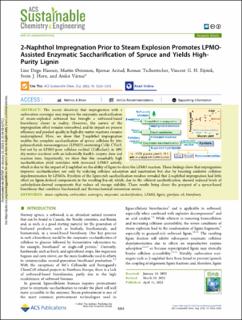2-Naphthol Impregnation Prior to Steam Explosion Promotes LPMO-Assisted Enzymatic Saccharification of Spruce and Yields High-Purity Lignin
Hansen, Line Degn; Østensen, Martin; Arstad, Bjørnar; Tschentscher, Roman; Eijsink, Vincent; Horn, Svein Jarle; Varnai, Aniko
Peer reviewed, Journal article
Published version
Permanent lenke
https://hdl.handle.net/11250/3061815Utgivelsesdato
2022Metadata
Vis full innførselSamlinger
Originalversjon
ACS Sustainable Chemistry and Engineering. 2022, 10 (16), 5233-5242. 10.1021/acssuschemeng.2c00286Sammendrag
The recent discovery that impregnation with a carbocation scavenger may improve the enzymatic saccharification of steam-exploded softwood has brought a softwood-based biorefinery closer to reality. However, the nature of the impregnation effect remains unresolved, and its impact on process efficiency and product quality in high-dry matter reactions remains underexplored. Here, we show that 2-naphthol impregnation enables the complete saccharification of spruce cellulose by lytic polysaccharide monooxygenase (LPMO)-containing Cellic CTec2, but not by an LPMO-poor cellulase cocktail (Celluclast), in 10% dry matter reactions with an industrially feasible enzyme dose and reaction time. Importantly, we show that this remarkably high saccharification yield correlates with increased LPMO activity, which is due to the impact of 2-naphthol on the ability of lignin to drive the LPMO reaction. These findings show that impregnation improves saccharification not only by reducing cellulase adsorption and inactivation but also by boosting oxidative cellulose depolymerization by LPMOs. Pyrolysis of the lignin-rich saccharification residues revealed that 2-naphthol impregnation had little effect on lignin-derived components in the resulting bio-oil, which, due to the efficient saccharification, showed reduced levels of carbohydrate-derived components that reduce oil storage stability. These results bring closer the prospect of a spruce-based biorefinery that combines biochemical and thermochemical conversion routes.
